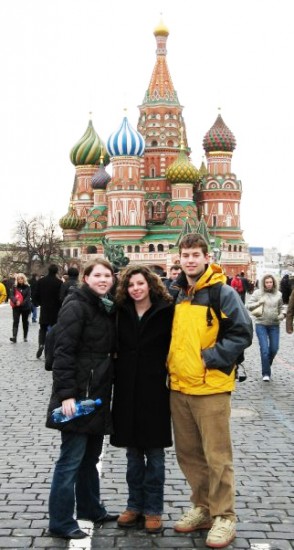
A group of students from the Russian 101/102 class in Spring 2008. Photo by Gillian Rowland-Kain.
For approximately ten years, Connecticut College students have been able to be whisked away to a foreign country for supplemental classroom studies. TRIP (Traveling Research and Immersion Program) occurs three or four times an academic year. Usually the TRIP takes place during Spring Break, but they have also been known to occur during the shorter Fall Break.
Shirley Parson, Director of Study Abroad and TRIP, cannot remember an exact beginning to the program, but did recall a number of professors approaching her to pursue “informal trips that evolved into the program we have today.”
The process begins with a professor submitting a proposal for a class trip, specifying where they would like to go and how the location connects with class material. After being approved by the Academic and Administrative Procedures Committee (AAPC) in addition to the Study Abroad office, the TRIP plans begin to solidify.
Budget issues limit the number of programs that are approved. While only a few occur per year, the College tries its best to cover all costs for the students, making the TRIP program, as Ms. Parson sighed, “so expensive.”
Many students think TRIPs are limited to the language and science departments, but there have been a variety of academic departments that have landed TRIPs.
Students in Mathematics and Science in the Elementary School (EDU 304) will be heading to Chiapas, Mexico, a location visited by SATA Oaxaca students during their Mexican tenure, for a program entitled “Indigenous Science and Critical Community Pedagogy.”
Initially, the group was supposed to participate in a cultural exchange, comparing education tactics with a rebel indigenous group, the Zapatistas. The Zapatistas are are a rebel/revolutionary group who has declared war against Mexico, although the war has generally been non-violent. They live mainly in the mountains in communities or “camps.”
“The Zapatistas basically have their own political system. They are a collective society in which the leadership is on a rotating basis, so you can only go in to the community if you are invited. We were invited, but then disinvited,” said Carolyn Kurz ’12.
The group of students was uninvited in early February, supposedly due to issues within the community. Instead, the group will join several symposiums and discussions at a local university, along with students and professors who have researched or worked with the Zapatista community. They will attend a half day conference concerning human rights in indigenous communities and take trips to various other communities.
Students in BIO 320, or Tropical Biology, will spend the first half of their spring break in Belize, with professors Stephen Loomis and Manuel Lizarralde. “Right now, we are learning the ecology of Belize,” said Kerry Dermody ’12. “We are setting up two experiments and writing research proposals in groups in preparation to gather field data when we are down there.” Most information will be gathered from reefers and mangrove swamps—the students will have to snorkel to complete their findings—then analyzed and written into a scientific paper.
Past TRIP programs have included an art history trip to Italy, led by Professor Joe Alchermes, where students traveled the ancient road Via Francigena between Rome and Canterbury, a program in Japan for students studying Japanese, and an excursion to Moscow and St. Petersburg with students in Russian 101.
“I loved it! It was a fantastic experience and we didn’t have to pay for anything. The school took care of our visas, our tickets, our hotel stay—everything,” said Gillian Rowland-Kain ’11, who went her freshman year. “I doubt that I would have gone to Russia otherwise so, for me, it was a great opportunity.” •








